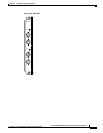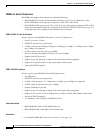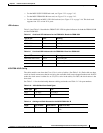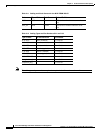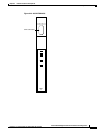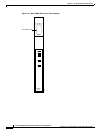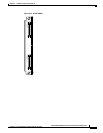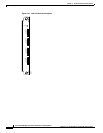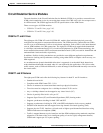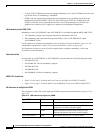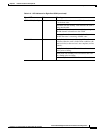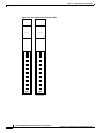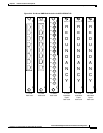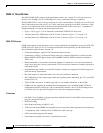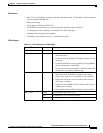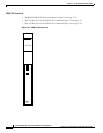
2-45
Cisco MGX 8230 Edge Concentrator Installation and Configuration
Release 1.1.31, Part Number 78-11215-03 Rev. B0, May 2001
Chapter 2 Module and Service Descriptions
Frame Relay Service Modules
Circuit Emulation Service Modules
The main function of the Circuit Emulation Service Module (CESM) is to provide a constant bit rate
(CBR) circuit emulation service by converting data streams into CBR AAL1 cells for transport across
an ATM network. The CESM supports the CES-IS specifications of the ATM Forum.
There are two types of CESM modules:
• CESM for T1 and E1 lines, page 2-45.
• CESM for T3 and E3 lines, page 2-50.
CESM for T1 and E1 lines
The eight-port AX-CESM-8T1 and AX-CESM-8E1 models allow individual physical ports to be
configured for structured or unstructured data transfer. The CESM provides constant-bit-rate (CBR)
services over an ATM network. It allows circuit-based equipment, such as PBXs, to be interconnected
over an ATM backbone via CBR connections. The eight port CESM cards support both channelized
(n x 64 Kbps) and unchannelized (T1/E1) circuit-based equipment. In ATM Forum terminology, the
terms structured data transfer (SDT) and unstructured data transfer (UDT) are used for channelized and
unchannelized circuit emulation, respectively.
In addition, flexible clocking mechanisms are provided to meet different application requirements.
Synchronous clocking and asynchronous clocking, using either SRTS or Adaptive clock recovery, are
both supported.
As an enhancement, dynamic bandwidth allocation is supported via on-hook/off-hook detection to
reduce backbone bandwidth consumed when it is not required by the applications. This allows other
traffic streams, such as VBR and ABR traffic, to take advantage of the bandwidth normally reserved for
the circuit traffic.
CESM T1 and E1 Features
The eight port CESM cards offer the following key features for both T1 and E1 interfaces:
• Standards-based AAL1
• Compliant with ATM Forum CES---V.2.0
• Choice of structured or unstructured data transfer per physical interface
• Time slots must be contiguous for n x 64-kbps fractional T1/E1 service
• Any n x 64-kbps channel can be mapped to any virtual circuit (VC)
• Choice of partially filled AAL1 cells per VC
• Supports Super Frame (SF) and Extended Superframe (ESF) framing modes
• Supports synchronous clocking for both UDT and SDT
• Supports asynchronous clocking for UDT, with SRTS and adaptive clock recovery methods
• ON/OFF hook detection and idle suppression using channel-associated signaling (CAS)
• Supports physical T1/E1 interfaces via back cards or higher speed channelized interfaces using
TDM infrastructure on backplane (SRM)
• Traffic is mapped between service interfaces and the ATM backplane using standards-compliant
adaptation. Consistent with Cisco's intelligent quality-of-service (QoS) management features,
CESM cards support per-VC express queuing.



